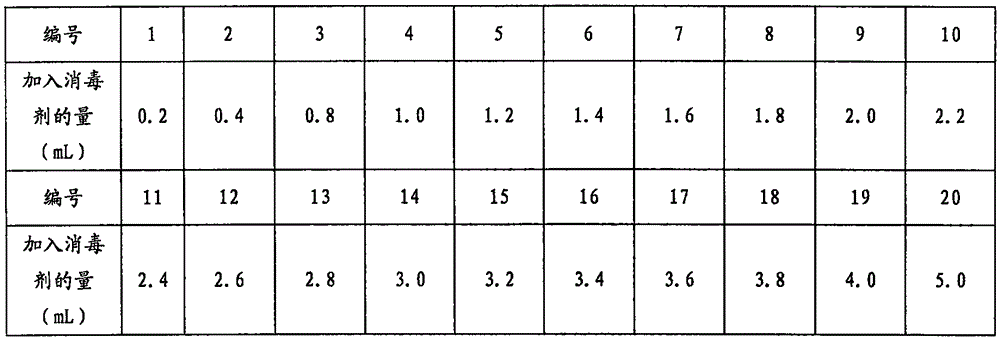Novel method for determination of escherichia coli residual in chlorine-containing disinfection waste water
A technology for Escherichia coli and chlorine disinfection, which is applied in the field of determination of Escherichia coli residues in chlorine-containing disinfection wastewater, and can solve the problems of low pollution and low cost.
- Summary
- Abstract
- Description
- Claims
- Application Information
AI Technical Summary
Problems solved by technology
Method used
Image
Examples
Embodiment 1
[0015] Analysis steps: Take 300mL of nutrient broth in sterile tanks, prepare 20 tanks, sterilize at 121°C for 15 minutes, add a loop (inoculation loop) of Escherichia coli liquid to each sterile tank, and incubate at 36°C for 24 hours , number each aseptic tank, add 10% sodium hypochlorite solution respectively, as shown in the table below:
[0016]
[0017] Put all the aseptic tanks for 2 hours (disinfectant action time) and then aseptically take 2mL to measure the value of free residual chlorine (GB / T5750.11-2006), and aseptically take 10mL in 10mL double lactose peptone Among them, 5 copies were inoculated in parallel, cultured at 36°C for 24 hours, and the acid and gas production were observed. Those without acid and gas production continued to culture for 24 hours, and a ring of acid and trachea production tubes was picked and drawn on the eosin-methylene blue agar plate, 36 Incubate at ℃ for 24 hours, observe whether there are typical colonies, pick a single typical ...
Embodiment 2
[0022] Analysis steps: Aseptically take 2 mL of domestic sewage sterilized with chlorine and measure the value of free residual chlorine to be 164 mg / L. To determine the presence of Escherichia coli residues, add 1 mL of 0.11 g / L sodium thiosulfate solution to 1 L of water sample, take 10 mL in double lactose peptone, inoculate 5 copies in parallel at the same time, and produce acid and gas after incubation at 36 °C for 24 hours, Pick a ring and streak it on the eosin methylene blue plate, culture it at 36°C for 24 hours, observe the colonies with black center and metallic luster, pick 5 single colonies and inoculate them in IMViC (used to determine the biochemical characteristics of Escherichia coli 4 (a) for biochemical identification and Gram staining. After 24 hours of incubation at 36°C, indigo matrix was positive, methyl red test was positive, acetylmethylmethanol test was negative, citrate test was negative, and Gram staining was negative without bacillus. . In line wi...
PUM
 Login to View More
Login to View More Abstract
Description
Claims
Application Information
 Login to View More
Login to View More - R&D Engineer
- R&D Manager
- IP Professional
- Industry Leading Data Capabilities
- Powerful AI technology
- Patent DNA Extraction
Browse by: Latest US Patents, China's latest patents, Technical Efficacy Thesaurus, Application Domain, Technology Topic, Popular Technical Reports.
© 2024 PatSnap. All rights reserved.Legal|Privacy policy|Modern Slavery Act Transparency Statement|Sitemap|About US| Contact US: help@patsnap.com










